James Pollard stands as a significant figure in British art, particularly renowned for his vibrant depictions of coaching, hunting, and equestrian life during the late Georgian and early Victorian periods. Born in 1792 and passing away in 1867, Pollard's work provides an invaluable visual record of a rapidly changing Britain, especially the bustling world of road travel before the dominance of the railways. His paintings capture the energy, the detail, and the social fabric of his time with a unique and enduring appeal.
Early Life and Artistic Formation
James Pollard was born in Islington, then a village just north of London, into a family already immersed in the world of art. His father, Robert Pollard (1755-1838), was a respected painter and, perhaps more significantly, a successful engraver and print publisher. This familial connection provided James with an immediate and immersive artistic education. From a young age, he was exposed to the techniques of drawing, painting, and engraving under his father's guidance.
The elder Pollard's business focused on producing prints, often of sporting and topographical subjects, which were popular with the growing middle class. James initially worked within the family enterprise, learning the craft and likely assisting his father in various capacities. This practical grounding in the production and dissemination of art prints undoubtedly shaped his understanding of popular taste and the commercial aspects of the art world.
His early artistic development also involved studying and copying the works of established masters. It is known that he honed his skills by emulating painters like Ben Marshall (1768-1835), a leading sporting artist of the preceding generation, known for his portraits of racehorses and hunting scenes. This practice of copying was a standard part of artistic training at the time, allowing young artists to understand composition, colour, and technique.
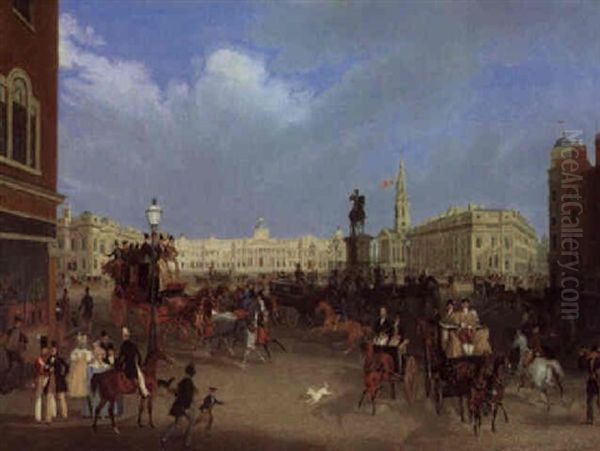
The family environment was supportive of James's burgeoning talent. However, they were also mindful of the social climate. During the early 1820s, the public controversy surrounding the trial of Queen Caroline (the estranged wife of King George IV) was intense. The Pollard family, aware of the potential damage that association with contentious public matters could inflict on a young artist's reputation, reportedly maintained a discreet unity, avoiding public entanglement in the affair to protect James's nascent career.
Artistic Style and Themes
James Pollard developed a distinctive artistic style characterized by bright colours, dynamic compositions, and a keen eye for detail. While perhaps not possessing the anatomical precision of a George Stubbs, Pollard excelled at capturing the energy and movement inherent in his chosen subjects. His paintings are rarely static; horses strain at their harnesses, coaches sway, dogs bound across fields, and crowds bustle with life.
His primary themes revolved around the horse and its role in British life. Coaching scenes are perhaps his most iconic subjects. He depicted the famous mail coaches, private carriages, and bustling coaching inns with meticulous attention to the details of the vehicles, the harnesses, the passengers' attire, and the surrounding architecture. These works often convey the speed, the occasional chaos, and the social interactions associated with road travel in the pre-railway era.
Fox hunting was another favourite subject, allowing Pollard to depict horses and hounds in full cry across the English countryside. He captured the excitement of the chase, the colourful pink coats of the riders, and the varied landscapes of rural England. Similarly, he painted horse racing scenes, often focusing on the spectacle of the event, including the crowds and the atmosphere of famous racecourses like Epsom or Newmarket.
Beyond these core subjects, Pollard also occasionally depicted other aspects of country life, such as fishing and shooting. His London scenes, like the notable painting of Trafalgar Square, demonstrate his ability to handle complex urban environments, filled with pedestrians, carriages, and omnibuses, capturing the vibrant, sometimes overwhelming, energy of the capital city.
While generally celebrated for their liveliness and historical detail, Pollard's works sometimes drew minor criticism, particularly regarding anatomical accuracy. Some observers noted that he occasionally depicted horses with legs that appeared overly long or slender. However, this stylistic trait rarely detracts from the overall impact and charm of his paintings, which prioritize narrative and atmosphere.
Career Highlights and Exhibitions
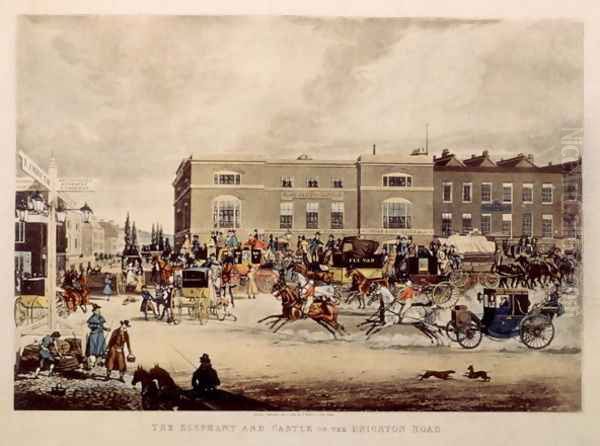
James Pollard's career gained momentum in the 1820s and reached its peak during the 1830s, coinciding with the zenith of the coaching era he so masterfully depicted. His skills became widely recognized, and his works found a ready market among coaching proprietors, sportsmen, and collectors interested in contemporary British life.
He sought recognition within the established art institutions of the day. Pollard exhibited his paintings regularly at the prestigious Royal Academy of Arts in London between 1821 and 1839. This provided him with a platform to showcase his work to a wider audience and gain critical notice. He also exhibited at the British Institution, another important venue for artists, with recorded showings in 1824 and 1844.
The popularity of his paintings was significantly amplified through the medium of printmaking. Many of his most successful compositions were engraved, often using the aquatint process favoured for sporting and topographical subjects, and published either by his father's firm or other print publishers. These prints made Pollard's imagery accessible to a much broader public than could afford original oil paintings, cementing his reputation as a chronicler of the coaching age.
Today, James Pollard's works are held in numerous public collections, attesting to his enduring significance. Notable institutions that house his paintings include the Tate Britain in London, the National Gallery of Art in Washington D.C., and the Art Institute of Chicago, among others. His art continues to be sought after by private collectors, particularly those interested in sporting art and British social history.
Collaboration with John Frederick Herring Sr.
A significant aspect of James Pollard's career was his collaboration with fellow artist John Frederick Herring Sr. (1795-1865). Herring was himself a highly successful painter, particularly renowned for his masterful depictions of horses, especially racehorses and farm scenes. He had even worked as a coachman in his earlier years, giving him intimate knowledge of his subjects.
Pollard and Herring frequently worked together on paintings, particularly those depicting horse racing scenes. Their collaboration followed a clear division of labour based on their respective strengths. Herring, with his exceptional skill in equine portraiture, typically painted the main subjects – the racehorses and their jockeys. Pollard, with his talent for lively compositions and detailed settings, would paint the surrounding elements – the crowds of spectators, the racecourse architecture, the distant landscapes, and the general atmosphere of the event.

This partnership proved highly effective, combining Herring's equine expertise with Pollard's flair for narrative context. The resulting paintings were often highly detailed, dynamic, and commercially successful. They represent a fascinating example of artistic synergy in the 19th century, where specialists combined their talents to create a richer final product.
Despite their close collaboration, their works also existed within the competitive art market of the time. Both artists were popular, and their individual and joint works were sought after. An anecdote about a jointly produced painting fetching a high price (£28,000, a substantial sum for the time) at auction after competitive bidding highlights both the market value of their combined efforts and the inherent competition within the art world, even among collaborators. Their relationship appears to have been one of mutual respect, shared artistic interests, and successful professional partnership.
Representative Works
Several paintings stand out as representative of James Pollard's oeuvre. His depictions of the Royal Mail coaches are particularly iconic. Works like The Royal Mail Coach on the Road or scenes depicting coaches departing from famous London inns capture the speed, efficiency, and importance of this service. He meticulously detailed the distinctive maroon and black livery of the mail coaches, the teams of four horses, the armed guard, and the varied passengers.
Trafalgar Square, painted likely between 1837 and 1843, is a masterful depiction of urban life. It showcases the newly completed square bustling with activity – horse-drawn omnibuses, carriages, pedestrians, and street vendors fill the scene, set against the backdrop of the National Gallery and St Martin-in-the-Fields. It vividly portrays the energy and congestion of London transport during the period.
Scenes of coaching inns, such as The Elephant and Castle on the Brighton Road, were another popular subject. These paintings often show coaches arriving or departing, passengers alighting or boarding, and the general hubbub of activity associated with these vital staging posts on the coaching routes. They offer glimpses into the social interactions and infrastructure that supported road travel.
His racing scenes, often created in collaboration with Herring Sr., such as depictions of the Epsom Derby or the St Leger Stakes at Doncaster, capture the thrill and spectacle of the turf. While Herring focused on the equine athletes, Pollard brought the surrounding event to life, illustrating the crowds, the tents, the bookmakers, and the general excitement of race day.
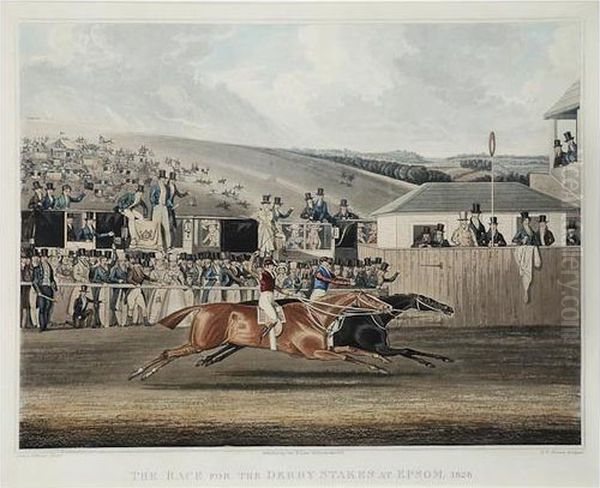
Fox hunting scenes, like The Kill or Full Cry, showcase Pollard's ability to render landscapes and dynamic action, capturing the energy of hounds and horses moving across the countryside. These works appealed strongly to the landed gentry and sporting enthusiasts who were often patrons of this genre.
Context: The World of British Sporting Art
James Pollard worked within a well-established tradition of British Sporting Art, a genre that had flourished since the early 18th century. This genre focused on subjects related to field sports (hunting, shooting, fishing), horse racing, coaching, and animal portraiture, particularly horses and dogs. Pollard's contribution lies firmly within this tradition, particularly in his focus on coaching and racing.
He followed in the footsteps of earlier pioneers of the genre. Artists like John Wootton (c. 1682-1764) and James Seymour (1702-1752) were among the first to specialize in sporting subjects, particularly horse racing and hunting, often working for aristocratic patrons. The towering figure of George Stubbs (1724-1806) revolutionized the field with his unparalleled anatomical studies of the horse, bringing a new level of realism and dignity to animal painting.
Pollard's direct contemporaries and influences included Ben Marshall, whom he copied early in his career. Marshall was known for his robust and characterful portraits of racehorses and sporting figures. John Frederick Herring Sr., his collaborator, was arguably the most popular painter of racehorses in the mid-19th century.
Other notable sporting artists active during or overlapping with Pollard's time include Henry Thomas Alken (1785-1851), famous for his lively, often humorous, hunting, coaching, and racing prints; Sawrey Gilpin (1733-1807), known for his elegant horse paintings; Philip Reinagle (1749-1833), who painted sporting subjects alongside landscapes and portraits; and the father-and-son artists Dean Wolstenholme Sr. (1757-1837) and Dean Wolstenholme Jr. (c. 1798-1883), both known for detailed hunting scenes.
A direct competitor in the specific niche of coaching scenes was Charles Cooper Henderson (1803-1877), whose works often rival Pollard's in their detail and accuracy regarding coaches and road life. Comparing their work highlights subtle differences in style and emphasis.
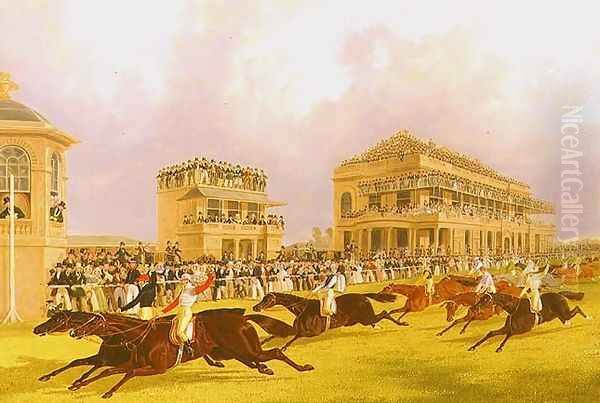
While specializing in sporting art, Pollard worked during a period of great artistic ferment in Britain. His lifetime overlapped with the towering figures of British landscape painting, J.M.W. Turner (1775-1851) and John Constable (1776-1837), who were revolutionizing the depiction of nature. Sir Edwin Landseer (1802-1873) achieved immense fame for his dramatic and often sentimental paintings of animals. Pollard's work, while focused on a specific genre, forms part of this broader tapestry of 19th-century British art. The tradition he represented would be carried forward later by artists like Sir Alfred Munnings (1878-1959) in the 20th century.
Legacy and Art Historical Significance
James Pollard's primary legacy lies in his role as a visual chronicler of the coaching age in Britain. His paintings and the prints made from them offer an unparalleled window into the world of road travel, sport, and daily life during the decades before the railway network transformed the country. He captured the peak of a transport system that had defined British life for centuries, just as it was about to decline.
His work is valued not just for its artistic merit but also as a rich source of social history. The detailed depictions of coaches, clothing, architecture, and social interactions provide valuable information for historians studying the period. He captured the dynamism, the colour, and sometimes the hazards of life on the road with an immediacy that text alone cannot convey.
Within the genre of British Sporting Art, Pollard holds a distinct place. While perhaps not reaching the anatomical heights of Stubbs or the widespread fame of Herring Sr. in equine portraiture, his specialization in coaching scenes, combined with his lively narrative style, carved out a unique niche. His ability to manage complex multi-figure compositions and convey a sense of atmosphere and movement remains impressive.
Despite occasional critiques of his technical rendering, particularly of horse anatomy, the enduring appeal of his work testifies to his skill as a storyteller and observer. His paintings are full of incident and detail that engage the viewer and bring the past to life. They celebrate the energy and spectacle of sport and travel, capturing a specific moment in British history with vibrancy and charm.
Conclusion
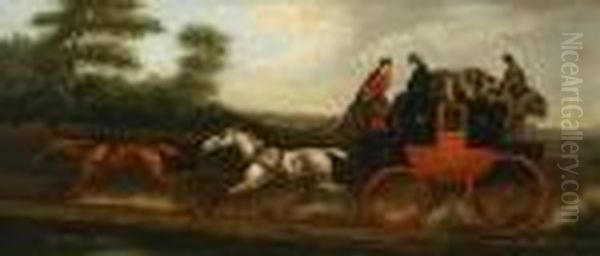
James Pollard remains a fascinating and important figure in British art history. As the son of a printmaker, he understood the market and the power of reproducible images. As an artist, he developed a distinctive style perfectly suited to capturing the energy and detail of the coaching era and the world of equestrian sports. His collaborations, particularly with John Frederick Herring Sr., highlight the specialized nature of sporting art during the period. More than just a painter of horses and coaches, Pollard was a visual historian, documenting the pulse of British life on the road and in the field during a time of significant social and technological change. His works continue to delight viewers and inform historians, securing his place as a key chronicler of 19th-century Britain.